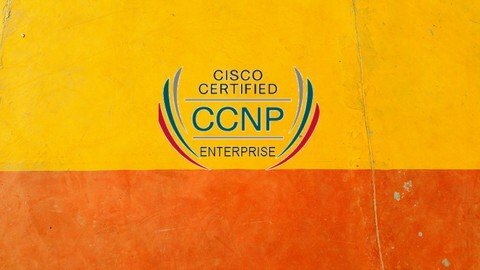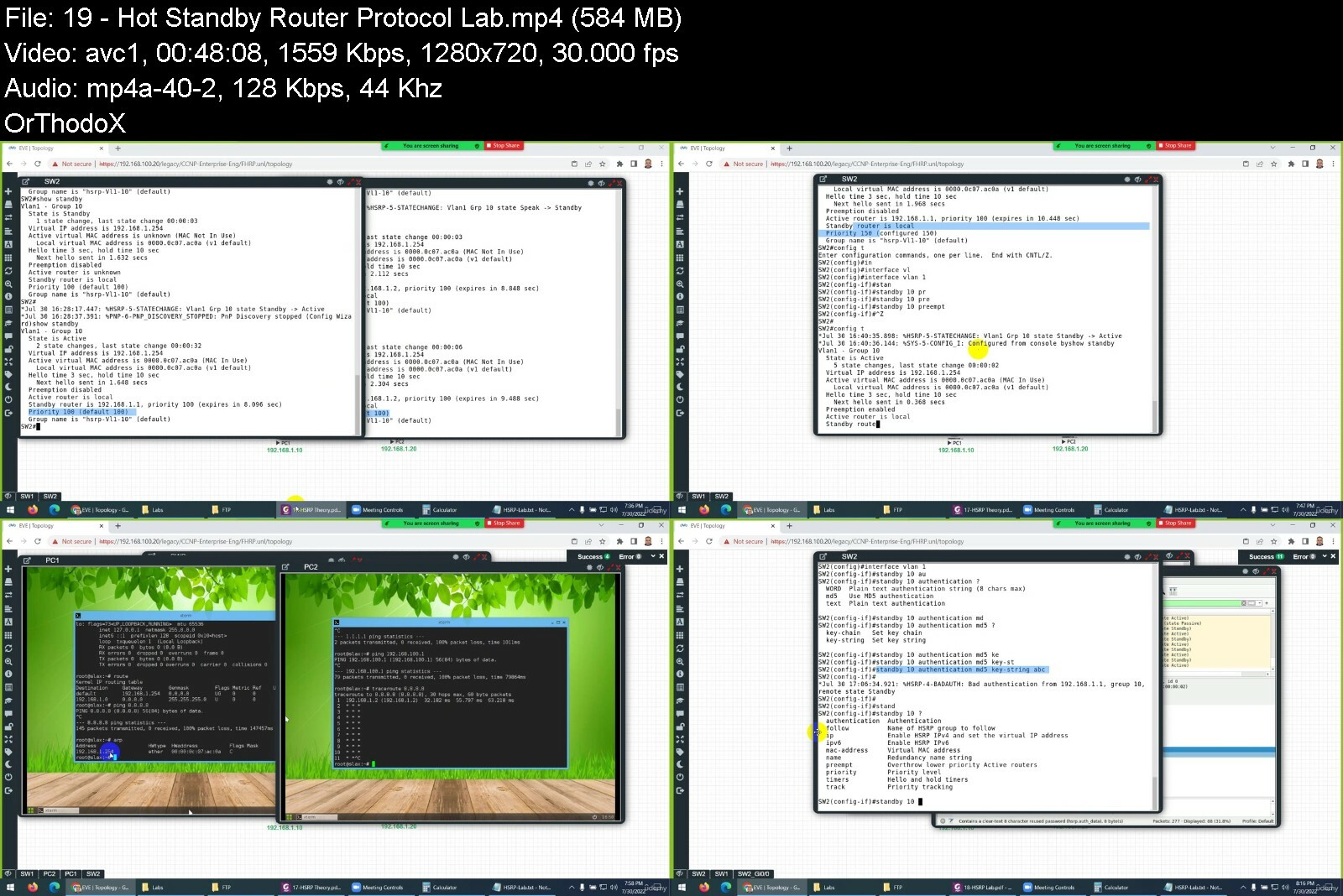
Ccnp Advanced Enterprise 350-401 Encor Part1/2
Published 11/2022
MP4 | Video: h264, 1280x720 | Audio: AAC, 44.1 KHz
Language: English | Size: 17.08 GB | Duration: 26h 44m
Learn CCNP Advanced Enterprise ENCORE with Step by Step Lab Workbook
What you'll learn
Anyone who wants to prepare for the CCNP Enterprise certification exams.
Anyone who wants to prepare for the CCNP exam
Routing, Switching , Automation, Security and Wireless
Get hands on experience for Cisco routers and switches
Configure, troubleshoot, and manage enterprise wired and wireless networks
Implement security principles within an enterprise network
Configure and verify advanced Cisco Switching technologies
Configure and verify advanced Cisco Routing technologies
Understand EtherChannel and It's Modes
Understand Static, Default, Floating and Dynamic Routing
Requirements
CCNA Routing & Switching Knowledge CCNA 200-125 or CCNA 200-301
General understanding of network fundamentals
General understanding of how to manage network devices.
Basic knowledge of how to implement LANs, network automation.
Basic Knowledge of GNS3, EVE NG or Packet Tracer Simulations
Description
The ENCOR - Implementing and Operating Cisco Enterprise Network Core Technologies v1.0 course gives you the knowledge and skills needed to configure, troubleshoot, and manage enterprise wired and wireless networks. You ll also learn to implement security principles within an enterprise network and how to overlay network design by using solutions such as SD-Access and SD-WAN. CCNP Enterprise training includes advanced routing, switching , troubleshooting , security, SDN etc. Educational training videos are supported with step-by-step configuration and troubleshooting examples so you can easily understand topics , get hands on experience and you can be a network professional. You will get important information about advanced routing, switching , tshoot , security , SDN etc. If you want to prepare for the CCNP Enterprise certification exams, this course will be a great step for you. The core exam is also the qualifying exam for CCIE Enterprise certification. This course gives you the knowledge and skills needed to configure, troubleshoot, and manage enterprise wired and wireless networks. You ll also learn to implement security principles within an enterprise network and how to overlay network design by using solutions such as SD-Access and SD-WAN.After taking this course, you should be able to:Illustrate the hierarchical network design model and architecture using the access, distribution, and core layersCompare and contrast the various hardware and software switching mechanisms and operation, while defining the Ternary Content Addressable Memory (TCAM) and Content Addressable Memory (CAM), along with process switching, fast switching, and Cisco Express Forwarding conceptsTroubleshoot Layer 2 connectivity using VLANs and trunkingImplementation of redundant switched networks using Spanning Tree ProtocolTroubleshooting link aggregation using EtherchannelDescribe the features, metrics, and path selection concepts of Enhanced Interior Gateway Routing Protocol (EIGRP)Implementation and optimization of Open Shortest Path First (OSPF)v2 and OSPFv3, including adjacencies, packet types, and areas, summarization, and route filtering for IPv4 and IPv6Implementing External Border Gateway Protocol (EBGP) interdomain routing, path selection, and single and dual-homed networkingImplementing network redundancy using protocols including Hot Standby Routing Protocol (HSRP) and Virtual Router Redundancy Protocol (VRRP)Implementing internet connectivity within Enterprise using static and dynamic Network Address Translation (NAT)Describe the virtualization technology of servers, switches, and the various network devices and componentsImplementing overlay technologies such as Virtual Routing and Forwarding (VRF), Generic Routing Encapsulation (GRE), VPN, and Location Identifier Separation Protocol (LISP)Describe the components and concepts of wireless networking including Radio Frequency (RF) and antenna characteristics, and define the specific wireless standardsDescribe the various wireless deployment models available, include autonomous Access Point (AP) deployments and cloud-based designs within the centralized Cisco Wireless LAN Controller (WLC) architectureDescribe wireless roaming and location servicesDescribe how APs communicate with WLCs to obtain software, configurations, and centralized managementConfigure and verify Extensible Authentication Protocol (EAP), WebAuth, and Pre-shared Key (PSK) wireless client authentication on a WLCTroubleshoot wireless client connectivity issues using various available toolsTroubleshooting Enterprise networks using services such as Network Time Protocol (NTP), Simple Network Management Protocol (SNMP), Cisco Internetwork Operating System (Cisco IOS) IP Service Level Agreements (SLAs), NetFlow, and Cisco IOS Embedded Event ManagerExplain the use of available network analysis and troubleshooting tools, which include show and debug commands, as well as best practices in troubleshootingConfigure secure administrative access for Cisco IOS devices using the Command-Line Interface (CLI) access, Role-Based Access Control (RBAC), Access Control List (ACL), and Secure Shell (SSH), and explore device hardening concepts to secure devices from less secure applications, such as Telnet and HTTPImplement scalable administration using Authentication, Authorization, and Accounting (AAA) and the local database, while exploring the features and benefitsDescribe the enterprise network security architecture, including the purpose and function of VPNs, content security, logging, endpoint security, personal firewalls, and other security featuresExplain the purpose, function, features, and workflow of Cisco DNA Center Assurance for Intent-Based Networking, for network visibility, proactive monitoring, and application experienceDescribe the components and features of the Cisco SD-Access solution, including the nodes, fabric control plane, and data plane, while illustrating the purpose and function of the Virtual Extensible LAN (VXLAN) gatewaysDefine the components and features of Cisco SD-WAN solutions, including the orchestration plane, management plane, control plane, and data planeDescribe the concepts, purpose, and features of multicast protocols, including Internet Group Management Protocol (IGMP) v2/v3, Protocol-Independent Multicast (PIM) dense mode/sparse mode, and rendezvous pointsDescribe the concepts and features of Quality of Service (QoS), and describe the need within the enterprise networkExplain basic Python components and conditionals with script writing and analysisDescribe network programmability protocols such as Network Configuration Protocol (NETCONF) and RESTCONFDescribe APIs in Cisco DNA Center and vManage
Overview
Section 1: Introduction & Lab Setup
Lecture 1 Lab Files and Workbooks
Lecture 2 Introduction to CCNP Enterprise
Lecture 3 Introduction to Different Simulators
Lecture 4 EVE NG Device Images & Links
Lecture 5 Install EVE-NG Community Edition
Lecture 6 Install EVE-NG Client Pack
Lecture 7 Upload Cisco IOS Routers
Lecture 8 Upload Cisco IOL IOU Switches
Lecture 9 Upload vIOS Routers and Switches
Lecture 10 Concept of Cisco Routers
Lecture 11 Basic Configuration of Routers
Section 2: Cisco Switches
Lecture 12 Concept of Cisco Switches
Lecture 13 Switch MAC Address Table
Lecture 14 Process & Fast Switching and CEF
Lecture 15 FIB, Adjacency Table and RIP Table
Lecture 16 Process, Fast Switching & CEF Lab
Lecture 17 First Hop Redundancy Protocol FHRP
Lecture 18 Hot Standby Router Protocol HSRP
Lecture 19 Hot Standby Router Protocol Lab
Lecture 20 Interface Tracking in HSRP
Lecture 21 Virtual Router Redundancy Protocol
Lecture 22 Virtual Router Redundancy Protocol Lab
Lecture 23 HSRP Load Sharing Theory
Lecture 24 HSRP Load Sharing Lab
Lecture 25 Concept of Dot1Q (IEEE 802.1Q)
Lecture 26 Dynamic Trunking Protocol
Lecture 27 Dynamic Trunking Protocol Lab
Lecture 28 VLAN Hopping Attack Lab
Lecture 29 Concept of EtherChannel
Lecture 30 LACP, PAgP and Manual Mode
Lecture 31 Link Aggregation Control Protocol Lab
Lecture 32 Port Aggregation Protocol PAgP Lab
Lecture 33 EtherChannel Static or Manual Lab
Lecture 34 Theory EtherChannel Load-Balancing
Lecture 35 EtherChannel Load-Balancing Lab
Lecture 36 EtherChannel Misconfiguration Guard
Lecture 37 Concept of SPAN
Lecture 38 Local Switched Port Analyzer Lab
Lecture 39 Remote Switched Port Analyzer Lab
Lecture 40 ERSPAN Lab
Lecture 41 Concept of Spanning Tree Protocols
Lecture 42 Need of STP in the Network
Lecture 43 STP Basic Terminologies
Lecture 44 Concept of STP Operation
Lecture 45 STP Root Port Selection
Lecture 46 STP Different Port Roles
Lecture 47 STP Different Port States
Lecture 48 Bridge Protocol Data Units
Lecture 49 Spanning Tree Protocols STP Lab
Lecture 50 Spanning Tree Protocols Adv Lab
Lecture 51 STP Different Timers
Lecture 52 Rapid Spanning Tree RSTP
Lecture 53 Rapid Spanning Tree Protocols Lab
Lecture 54 Concept of Multiple Spanning Tree
Lecture 55 Multiple Spanning Tree MSTP Lab
Section 3: Cisco Routing
Lecture 56 Routed & Routing Protocols
Lecture 57 AD Value and Metric
Lecture 58 Static Routing & Static Route Types
Lecture 59 Static and Default Routing Lab
Lecture 60 Static Routing Routes Types Lab
Lecture 61 Floating Static Route
Lecture 62 Floating Static Route Lab
Lecture 63 Concept of ARP and ARP Types
Lecture 64 IP Routing & ARP Packet Flow Lab
Lecture 65 Verify Longest Match
Lecture 66 Dynamic Routing Protocols
Section 4: Dynamic Protocols EIGRP
Lecture 67 Routing Protocols EIGRP
Lecture 68 Routing Protocols EIGRP Lab
Lecture 69 Dynamic Protocols EIGRP Tables
Lecture 70 EIGRP Metric Calculation
Lecture 71 EIGRP Five Packet Types
Lecture 72 EIGRP Path Optimization
Lecture 73 EIGRP Terminologies
Lecture 74 EIGRP Summarization Theory
Lecture 75 EIGRP Summarization Lab
Lecture 76 EIGRP Load Balancing Theory
Lecture 77 EIGRP Load Balancing Lab
Section 5: Dynamic Protocols OSPF
Lecture 78 Dynamic Routing Protocols OSPF
Lecture 79 OSPF Terminologies
Lecture 80 Dynamic Routing Protocols OSPF Lab
Lecture 81 Dynamic Protocols OSPF Tables
Lecture 82 OSPF Neighbor Adjacencies
Lecture 83 OSPF Metric Calculation
Lecture 84 OSPF Packet Header & Types
Lecture 85 OSPF Router ID Selection
Lecture 86 OSPF Different Router Types
Lecture 87 OSPF Different Routes Types
Lecture 88 OSPF DR and BDR Election
Lecture 89 OSPF equal Load Balancing
Lecture 90 OSPF Summarization Theory
Lecture 91 OSPF Summarization LAB
Lecture 92 OSPF Filtering Theory
Lecture 93 OSPF Filtering ACL Lab
Lecture 94 OSPF Passive Interfaces
Lecture 95 OSPF Network Types Theory
Lecture 96 OSPF Network Types Lab
Network administrators, Network support technicians, Help desk technicians,Enterprise network engineers, System engineers, System administrators
https://anonymz.com/?https://www.udemy.com/course/ccnp-advanced-enterprise-350-401-encor-part12/

https://rapidgator.net/file/8a22371f993c439320017debf2601de5/CCNP_Advanced_Enterprise_350401_ENCOR_Part12.part1.rar https://rapidgator.net/file/768f93c7417df23a2ab01879c0de032e/CCNP_Advanced_Enterprise_350401_ENCOR_Part12.part2.rar https://rapidgator.net/file/02a7fefa90fecc4a18b0cebcee6f3a17/CCNP_Advanced_Enterprise_350401_ENCOR_Part12.part3.rar https://rapidgator.net/file/e03cb9455edc4aeac31ec309d473afd0/CCNP_Advanced_Enterprise_350401_ENCOR_Part12.part4.rar
https://nitroflare.com/view/A3B901F76FC5796/CCNP_Advanced_Enterprise_350401_ENCOR_Part12.part1.rar https://nitroflare.com/view/14DEAE0D465573B/CCNP_Advanced_Enterprise_350401_ENCOR_Part12.part2.rar https://nitroflare.com/view/DA7E46C531AC9CC/CCNP_Advanced_Enterprise_350401_ENCOR_Part12.part3.rar https://nitroflare.com/view/0E3A40C2B6C34D1/CCNP_Advanced_Enterprise_350401_ENCOR_Part12.part4.rar

